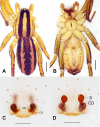The revision and phylogenetic position of Hippasa bifasciata Buchar, 1997 (Araneae, Lycosidae)
- PMID: 40894274
- PMCID: PMC12395185
- DOI: 10.3897/BDJ.13.e166495
The revision and phylogenetic position of Hippasa bifasciata Buchar, 1997 (Araneae, Lycosidae)
Abstract
Background: Hogna Simon, 1885 is the second-largest genus in the family Lycosidae after Pardosa C. L. Koch, 1847 (517 species), including 232 species so far. This genus has a cosmopolitan distribution spanning multiple continents. However, only four species (Hogna rubetra (Schenkel, 1963), Hogna trunca Yin, Bao & Zhang, 1996, Hogna jiafui Peng, Yin, Zhang & Kim, 1997 and Hogna arborea Lo, Wei & Cheng, 2023) have been recorded in China.
New information: A new combination, Hogna bifasciata (Buchar, 1997), comb. nov. (from Yunnan and Sichuan Provinces in south-western China), is proposed with both morphological and molecular evidence. Detailed morphological descriptions, photographs, scanning electron micrographs and a distribution map are provided. This species is distinguished from congeners by the unique structure of the female epigyne and its somatic pattern. Molecular phylogenetic analyses suggest H. bifasciata (Buchar, 1997) and all analysed Hogna species cluster together within the subfamily Lycosinae and the species is sister to the group, including Hogna frondicola Emerton, 1885, Hogna carolinensis Walckenaer, 1805 and Hogna crispipes L. Koch, 1877.
Keywords: Lycosinae; DNA barcoding; morphology; new combination; phylogeny; taxonomy.
Changjun Wu, Zehong Tao, Yang Wang, Yufa Luo.
Figures




References
-
- Álvarez-Padilla F., Hormiga G. A protocol for digesting internal soft tissues and mounting spiders for scanning electron microscopy. Journal of Arachnology. 2007;35(3):538–542. doi: 10.1636/sh06-55.1. - DOI
-
- Brady A. R. Nearctic species of the new genus Tigrosa (Araneae: Lycosidae) Journal of Arachnology. 2012;40:182–208. doi: 10.1636/K11-77.1. - DOI
-
- Brignoli P. M. A catalogue of the Araneae described between 1940 and 1981. Manchester University Press, Manchester; 1983.
-
- Buchar J. Lycosidae aus Bhutan 1. Venoniinae und Lycosinae (Arachnida: Araneae) Entomologica Basiliensis. 1997;20:5–32.
-
- Folmer O., Black M., Hoeh W., Lutz R., Vrijenhoek R. DNA primers for amplification of mitochondrial cytochrome c oxidase subunit I from diverse metazoan invertebrates. Molecular Marine Biology and Biotechnology. 1994;3(5):294–299. - PubMed
LinkOut - more resources
Full Text Sources
